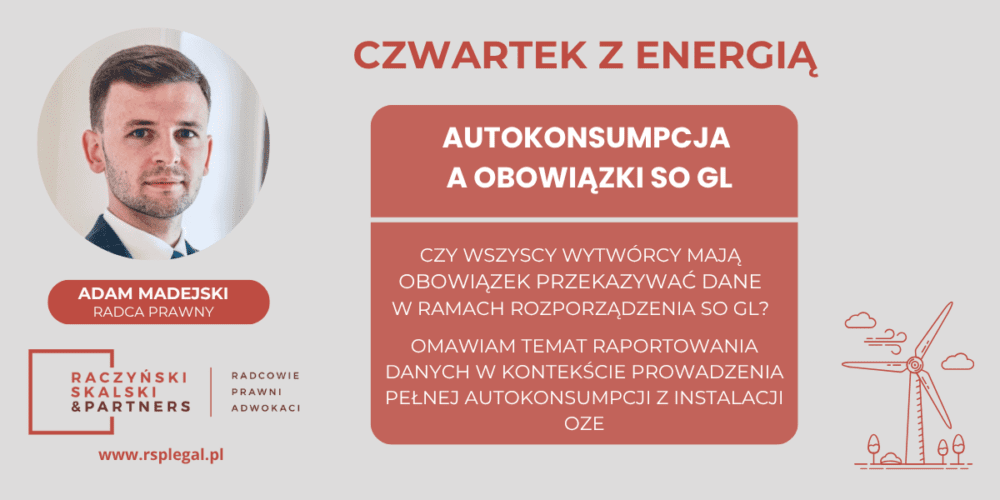1.SO GL in brief
SO GL is a popular abbreviation for Commission Regulation (EU) 2017/1485 of 2 August 2017 establishing guidelines for the operation of the electricity transmission system. The provisions of SO GL are directly applicable, which means that no legal acts had to be introduced into the national legal system for SO GL to apply to entities conducting activities related to electricity generation in Poland.
Importantly, the provisions of SO GL apply not only to producers in RES installations, but to all entities producing electricity, including from conventional sources.
One of the most important concepts in SO GL is ‘SGU’, which stands for significant grid user, i.e. an entity whose activities have or may have an impact on the operation of the electricity grid. In practice, SGU refers to producers operating energy generation modules (‘MWE’) classified as category B, C or D. Category A modules (with a capacity of up to 200 kW) are not subject to SO GL regulations.
The terminology used in SO GL is borrowed from certain other legal acts relevant to the functioning of the power system. One such act is Commission Regulation (EU) 2016/631 of 14 April 2016 establishing a network code on requirements for grid connection of generators (“NC RfG”). It is in the NC RfG that the definition of a power generation module is contained, which is understood as:
- A synchronous module, i.e. conventional power plants, hydroelectric power plants,
- An energy park module, i.e. non-synchronous power plants, such as photovoltaic power plants.
2.Categories of power generation modules
From a national perspective, an important document is the so-called TCM, i.e. the document ‘Scope of data exchange for the purposes of planning and operating the National Power System (method from Article 40(5) of SO GL concerning the scope of exchanged data)’, developed by PSE S.A. The TCM contains details on how to classify SMEs into categories A, B, C or D. According to the TCM:
- module A is an SME with a capacity of 0.8 to 200 kW,
- module B is an SME with a capacity of 200 kW to 10 MW,
- module C is an MWE with a capacity of 10 to 75 MW,
- module D is an MWE with a capacity of 75 MW or higher.
SMEs comprise an energy generation plant, which is understood as a plant that converts primary energy into electricity and consists of one energy generation module or more than one energy generation module connected to the grid at at least one connection point. The entity that owns the energy generation plant is subject to the obligations set out in SO GL.
3.Scope and form of reporting obligations
In accordance with TCM, owners of energy generation plants are required to report a specific set of data depending on the category of SMEs that make up their plant. In each case, however, the data is divided into three groups
- structural data,
- planning data,
- real-time data.
In practice, data reporting is carried out:
- for structural data – via an internet portal provided by the DSO or directly to the TSO in accordance with the grid connection agreement. Work is underway on the Structural Data Exchange Portal.
- for planning data – via an internet portal provided by the DSO or via the Planning Data Exchange Portal developed by PSE S.A.
- For real-time data – via installation management software, e.g. SCADA, in accordance with the operator’s recommendations.
4.SO GL and self-consumption
In the context of SO GL regulations, a fundamental question arises: are producers whose installations operate exclusively in self-consumption mode, without the possibility of feeding energy into the grid, also subject to data reporting obligations? The answer is yes! The data entered by a producer using full self-consumption is also important for electricity system operators, as it contains information about:
- The existence of a generating unit connected to the grid at a given facility,
- Possible changes in the facility’s electricity demand in the short and long term,
- The possibility of feeding electricity into the grid by the producer in the event of technological changes, changes in connection conditions or in the event of a failure of devices blocking the flow of electricity into the grid.
From the point of view of an operator managing thousands of consumption facilities and generation installations, every piece of information can be important. In accordance with point 3.3. TCM, owners of all categories of small wind turbines, when submitting structural data, select the option ‘autogeneration’, understood as ‘the ability of the SGU to fully or partially cover its own electricity demand, using its own power grid, excluding the needs of the small wind turbine itself’. Therefore, in each case where a producer subject to the obligations under SO GL submits structural data, it is required to specify whether it engages in autogeneration.



